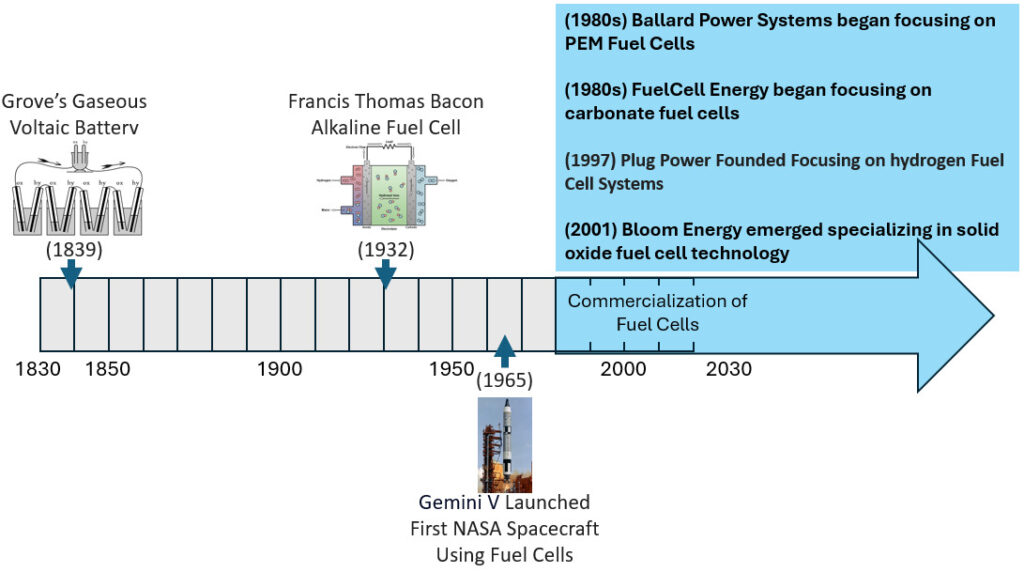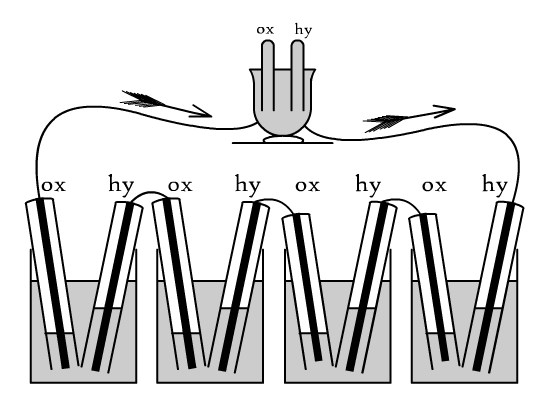Fuel cells have a long and fascinating history, showcasing the ingenuity and persistence of scientists and engineers striving for cleaner energy solutions. From their conceptual beginnings in the 19th century to their role in modern renewable energy systems, fuel cells have evolved significantly, demonstrating their potential to transform energy generation. This article explores the key events and milestones that have shaped the history of fuel cells, providing a deeper understanding of their impact on science, technology, and society.

Origins of Fuel Cells: Early Discoveries and Innovations

The foundation of fuel cell technology was laid in 1839 by Sir William Grove, a Welsh scientist often called the “father of the fuel cell.” Grove’s invention, the “gas voltaic battery,” was a pioneering device that combined hydrogen and oxygen to produce electricity and water. While its potential was clear, the lack of affordable materials and hydrogen infrastructure relegated his invention to the laboratory for decades.
By the 20th century, fuel cell technology gained momentum as scientists like Francis Thomas Bacon advanced Grove’s work. Bacon’s development of the alkaline fuel cell in 1932 introduced efficiency and affordability, making practical applications more feasible. These early strides inspired ongoing research and applications across various industries.
Pioneering Applications: Space Exploration and Beyond
Fuel cells became a cornerstone of technological innovation during the space race. NASA adopted fuel cells in the 1960s for Gemini and Apollo missions, leveraging their ability to generate electricity and water in space. This dual-purpose technology provided astronauts with a reliable energy source in the harshest conditions.
General Electric’s development of proton exchange membrane (PEM) fuel cells during this era opened the door to more compact, lightweight designs. Their success in space exploration demonstrated fuel cells’ reliability and inspired a broader exploration of terrestrial applications.
Commercialization and Widespread Applications
The late 20th century marked a shift from experimental fuel cells to commercial solutions. Advances in technology and the growing focus on sustainability drove adoption across various sectors.
Automotive Innovations
Hydrogen fuel cell vehicles (FCVs) emerged as a viable alternative to traditional combustion engines, offering zero emissions and high efficiency. Toyota’s Mirai and Hyundai’s Nexo showcase the potential of PEM fuel cells to power vehicles with only water vapor as a byproduct. Public transportation has also embraced fuel cell technology, with hydrogen-powered buses and trains reducing greenhouse gas emissions globally.
Stationary Energy Solutions
Stationary fuel cells, particularly those using solid oxide fuel cell (SOFC) technology, have revolutionized energy solutions for buildings and industrial sites. Companies like Bloom Energy have pioneered scalable systems that provide reliable, off-grid energy, especially in regions with unstable power grids or stringent environmental regulations.
Portable Energy Applications
Portable fuel cells have found niches in powering electronic devices, military equipment, and emergency systems. Their independence from the grid and compact design make them indispensable in remote and critical scenarios.
Milestones in Fuel Cell Development
- 1960s: General Electric developed PEM fuel cells for NASA’s Gemini missions, demonstrating their potential for space exploration.
- 1980s:
- Ballard Power Systems focused on PEM technology, laying the groundwork for hydrogen-powered transportation.
- FuelCell Energy specialized in carbonate fuel cells, driving industrial-scale power generation advancements.
- 1994: Siemens Westinghouse installed the first SOFC system at Southern California Edison’s Highgrove Generating Station, proving its potential for stationary applications.
- 1997: Plug Power introduced hydrogen fuel cell systems, including solutions for forklifts and stationary energy.
- 2001: Bloom Energy revolutionized SOFC technology, enabling efficient and sustainable power generation.
- 2013: Toyota’s Mirai prototype highlighted the commercial viability of hydrogen FCVs.
- 2015: The Hydrogen Council united industry leaders to accelerate global hydrogen adoption.
- 2020: Cummins Inc. acquired Hydrogenics, strengthening expertise in PEM fuel cells, electrolyzers, and hydrogen storage.
- 2024: BMW, in collaboration with Toyota, announced plans for its first hydrogen-powered vehicle by 2028.
Envisioning a Sustainable Future
Fuel cells are poised to play a transformative role in the global energy transition. Innovations in hydrogen production, such as renewable-powered water electrolysis, are lowering costs and addressing sustainability challenges. Investment in infrastructure, including pipelines, refueling stations, and storage facilities, is rapidly expanding worldwide.
Fuel cells’ ability to integrate seamlessly with renewable energy sources offers a promising solution to energy intermittency. Excess solar or wind power can be stored as hydrogen, which fuel cells can convert back into electricity during high demand, creating a stable, sustainable energy cycle.
The transportation sector continues to benefit from fuel cell technology, with hydrogen-powered vehicles and aircraft reducing carbon emissions. Companies like Airbus and Nikola are exploring hydrogen solutions for aviation and freight, while stationary fuel cells are reshaping energy use in hospitals, data centers, and remote areas.
Building a Low-Carbon Economy with Fuel Cells
The journey of fuel cells, from Sir William Grove’s experiments to today’s cutting-edge applications, highlights their versatility and transformative potential. Advances in production, storage, and scalability are turning what was once a niche technology into a critical pillar of global energy strategies.
As governments, businesses, and researchers collaborate on innovations, fuel cells are no longer just a vision for the future—they are a reality driving the shift to a cleaner, more sustainable world. Their ability to bridge the gap between renewable energy and reliable power positions them as a cornerstone of the low-carbon economy.
